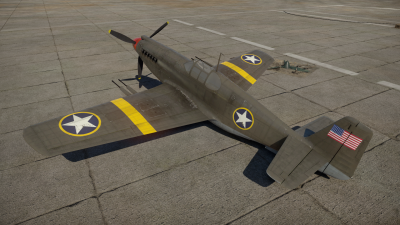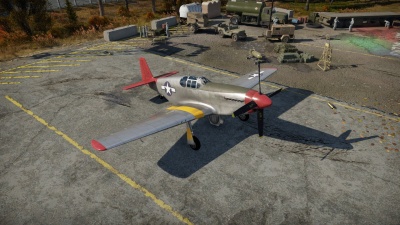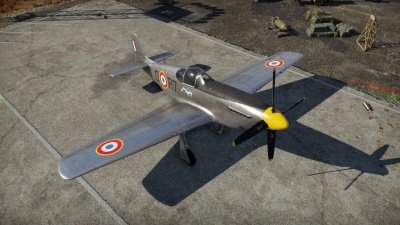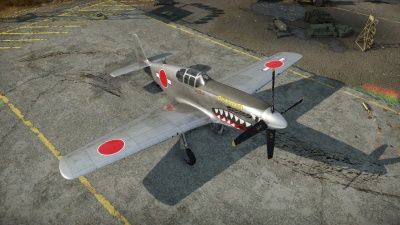P-51 (Family)
Contents
History of family
World events
Germany had built up enormous production capabilities and was churning out aircraft using the latest technology. Britain and France quickly realized they were well behind the manufacturing capacity of Germany and looked to American manufacturing to catch up.
The proposal
Britain wanted the Curtiss P-40 fighter but they were at production capacity so instead asked North American Aviation (then known for the B-25 "Mitchell" bomber and AT-6 "Harvard" trainer also purchased for the RAF) about making the P-40. NAA President James Howard "Dutch" Kindelberger proposed he could design a new, better fighter in less time than getting licenses for the P-40.
Birth of a legend
In just 102 days after the agreement the NA-73X rolled out of the factory, flying 47 days later, an incredibly short time. 2 key differences on the NA-73X compared to contemporary fighters were moving the oil and water radiators to the rear of the aircraft with extensive duct work, and new "laminar flow" wing airfoils. The NAA/NACA 45–100 airfoil was a brand new invention that promised significantly reduced turbulence, thus drag, at high speed. Kindelberger gambled the company on this new airfoil delivering the performance desired, since the airfoil data was mostly theoretical. Much to relief of NAA the finished aircraft performed well and orders were put in (one of the prototype NA-73X provided to the USAAC (XF-51) still exists today! BuNos 41-038, NX51NA).
Polishing the Diamond
Pleased with the new fighter, on 24 April 1940 the British commission purchased 320 NA-73s, plus 300 updated units labelled NA-83s, all of which were designated "North American Mustang Mark I" by the RAF. Although the purchase was before the Blitzkrieg and Battle of Britain, it was not until October 1941 when they were delivered in UK with the first Mustang Mk Is entering service in January 1942. Unfortunately the installed Allison V-1710 engine of the Mark I's had poor high altitude performance, so missions were relegated to low altitude recon and ground attacks, which was actually a poor mission type for the laminar flow wing! Despite this the Mustang was seen as winning design by pilots and engineers so effort was made to improve it. In April 1942 Rolls-Royce was invited to test the Mk 1, they did not take long to see its potential, installing a much better Merlin 61 engine and naming it the Mustang Mk X. Fitting the engine was not difficult, but an extra chin radiator was needed because the existing radiator was insufficient for the more powerful and hotter engine. While it looked funny, the performance was anything but, exceeding expectations and leaving the legendary Spitfire in the rear view. The Mk X proved the hypothesis and the push was on to put a British engine in a fighter built and paid for the British.
British have a Mustang fan club
Meanwhile across the Atlantic the USAAC was not that enthusiastic about their recent addition, the newly designated P-51. The generals stubbornly believed a heavily armed bomber was better, and if they did need escorts then the P-38 and P-47 were a better choice. After Pearl Harbor more resources went to naval aircraft and bombers. When the first USAAF bombing missions from England against Nazi German started it did not take long to realize they had to change bombing tactics. The British were more than eager to show the Americans the new fighter and pushed for the US company Packard to build the Merlin (Packard V-1650-3 Merlin). By early 1943 the Merlin powered P-51B/Mustang Mk III was rolling off the assembly line and into history.
A most British of aircraft
One can write books on the exploits of the P-51 but for here will just hit the high points. While most well known for missions in Europe, they were also critical in escorting B-29's over Japan. After the war P-51 was retained while all the other land-based piston fighters were decommissioned. They were critical in the Korean War, once again being heavily used for ground attack as jets now ruled the skies. Mustangs do not account for any unique combat record, but that does not diminish its incredible impact on combat operations, including the first engagements against jet fighters over Germany. All this happened because the British not only funded its design and provided a superior engine, but also enthusiastically encouraged the USAAF to develop and use it.
Legacy
P-51s were sold to dozens of countries military for years after, and to individuals as private aircraft. They became popular racing aircraft and are a staple at air shows all over the world. Today over 150 airworthy P-51s fly, and hundreds more found in museums adding to the legend and mythos. A footnote, when Ford Motors introduced a sporty new car the name Mustang was selected not for the horse but after the P-51; it too is a legendary vehicle.
The Mustangs!
| P-51 | |
|---|---|
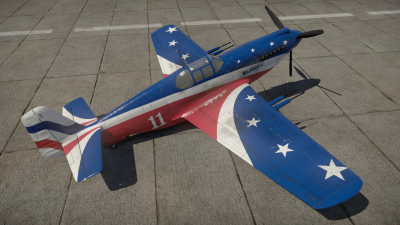
|
The first order of Mustangs to the British were designated Mustang Mk I. The RAF received these aircraft behind schedule in October of 1941. Problems showed up immediately including the Allison power-plant and other design flaws. It is also important to note the Mustang Mk I's armament consisting of four .30 cal machine guns mounted in the wings, as well as a set of two .50 cal mounted in the wings and two .50 cal machine guns mounted in the nose. The next evolution of this aircraft was designated Mustang Mk IA. Due to the recently signed Lend-Lease Act the U.S. Army was able to place an order for 150 more Mustangs on behalf of the British. These aircraft were equipped with four 20 mm Hispano Mk.II cannons mounted in the wings. Only 93 of the new Mustangs made it to the RAF. The U.S. Army pulled 55 for themselves and they immediately saw service. Two were kept by North American Aviation for internal use. These P-51 Mustangs first saw service in April 9th of 1943 and the first combat loss came shortly afterwards on April 23rd. |
| Mustang Mk. IA, Royal Air Force | |
|---|---|
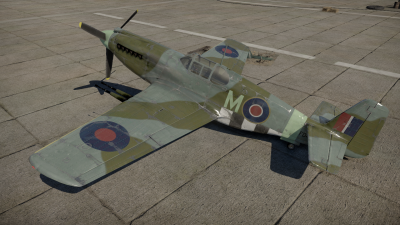
|
The North American P-51 Mustang was a single seat fighter which was designed, developed and entered service all during the course of the Second World War. The origins of the aircraft came about in April 1940, when the British Purchasing Commission approached the North American aviation company to design a fighter to augment those already in service with RAF Fighter Command. The prototype first flew on October 26th 1940 and, after a highly successful test and evaluation period, 320 aircraft were ordered and the first production aircraft flew on May 1st 1941. Delivered to No.26 Squadron at Gatwick, the new American fighter was designated the Mustang Mk.I by the RAF. It was considered to be superior to any other American fighter at the time, particularly at low level. However, the 1,100 hp Allison V-1710 engine had a poorer performance at high altitude, particularly above 15,000 feet which was above where the engine supercharger was optimized for. |
| A-36 | |
|---|---|
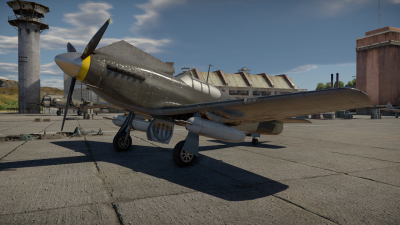
|
Dive-bombing ground attack version, just like previous version it was equipped with the Allison V-1710 engine (this one with the -87 variant) and had two additional M2 Browning machine guns installed under the engine. The wings were modified to fit new dive brakes to slow down the aircraft in dives, and two hard points for 500 lb or other types of bombs were also added. Flight performance was slightly reduced because of increased weight. |
| P-51A | |
|---|---|
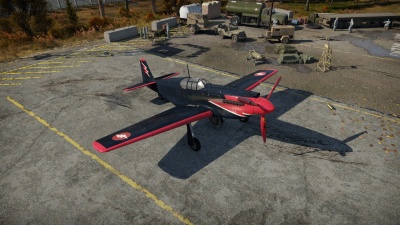
|
The last version fitted with the Allison engine. It was meant to be a pure fighter. Performance at medium altitude has been improved because of new engine version (V-1710-81), in War Thunder it can reach 404 mph at 10,000 ft and 391 mph at 16,000 ft. Its armaments were four M2 Browning machine guns mounted in both wings. It was possible to install two hard points under wings to carry bombs up to 500 lb or drop tanks. Overall the plane was almost identical to the first P-51 version equipped with machine guns. The plane was used as a fighter or escort in the China/Burma/India theatre. Production was stopped as soon as the Merlin powered variant was introduced. |
| P-51C-10 | |
|---|---|
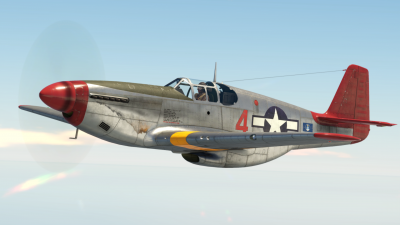
|
In-game representation of the first version equipped with the Merlin engine, the C version produced by Dallas plant. Just like the P-51A it was armed with four .50 cal M2 Browning machine guns, wings remained unchanged and the main change was the new engine. This exact version has the V-1650-7 engine installed, licensed version of the Merlin 66 engine, which was a huge improvement over the previous one because of the two stage turbocharger, it allowed the plane to reach 445 mph at 21,200 ft. The other visual change was carburetor air intake position, in the previous versions it was placed above the nose, meanwhile all Merlin powered versions had it below. Earlier B and C versions used the V-1650-3 version of this engine, which was a licensed Merlin 61. This plane like previous versions suffered the same problems like poor rear visibility, jamming guns, or only four machine guns, which were addressed in the next versions. |
| ▅P-51C-11-NT | |
|---|---|
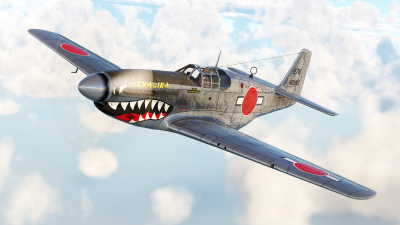
|
The P-51C-11 Evalina named after the girlfriend of pilot First Lt. Oliver E. Strawbridge. His plane got captured in China while being piloted Second Lt. Sam McMillan on 16 January 1945. With the Japanese having their hands on their first-ever functional P-51 and still looking for flaws in the design to even out the odds, made the plane go through extensive evaluation, examination and mock air battles. She's one of the few P-51's Japan got their hands on. Evalina would eventually give in before the war was over and her generator burnt out. With the lack of replacement parts she would be bulldozed into a lake to be never seen again. |
| P-51D-5 | |
|---|---|
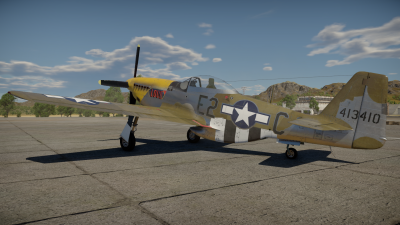
|
The most famous Mustang version was the P-51D with teardrop (or bubble) canopy. The main problem for the pilots of the earlier variants was a huge blind spot at the rear of the aircraft due to the canopy design. An earlier attempt to address the issue was a British-designed Malcolm hood, installed on many P-51Bs. It improved rearward visibility, but the search for a better solution continued. In January 1943, USAAF's Colonel Mark Bradley, while stationed in Britain, was introduced to the then-new "bubble" canopy, designed for use on Spitfires and Typhoons. The canopy had no framework and offered near 360-degree vision. To install the new canopy, the rear fuselage section of the Mustang had to lose some height. However, this change required minimal redesign to the airframe. The inaugural flight of the new P-51D took place at Inglewood, California on 17th November 1943. |
| Wetmore's P-51D-10 | |
|---|---|
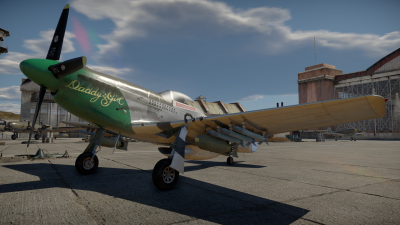
|
Ray S. Wetmore (September 30, 1923 – February 14, 1951) was a U.S. ace of World War II. He joined the U.S Army Air Corps in 1941 at the age of 18 and was assigned to the 359th fighter group. He achieved his first 4 victories in the sky while flying a P-47 Thunderbolt before making the switch to a P-51B and then a P-51D-10 named 'Daddy's Girl'. He was later shot down by friendly anti-aircraft fire during the battle of the Bulge but survived, finishing the war with a documented 21 German aircraft destroyed. He died in 1951 while flying a F-86 Sabre that he suddenly lost control of during an approach to an airfield. |
| P-51D-20-NA | |
|---|---|
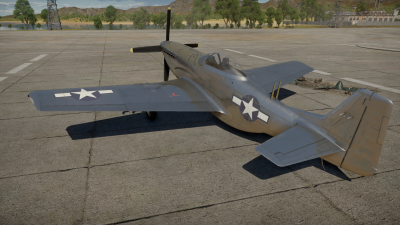
|
The D-20 variant has the same improvements as in the D-10 with the exception of engine settings and fuel type, both the D-5 and D-20 share the same settings in War Thunder. The D-20 was also the first to receive the K-14 gunsight in factory, but it could be installed in all other versions. New gunsight was meant to improve the overall accuracy including in high deflection attack, pilot had to adjust the circle size to match the enemy's plane wingspan and then put it in gunsight and pull the trigger. |
| P-51D-20, Republic of China Air Force | |
|---|---|
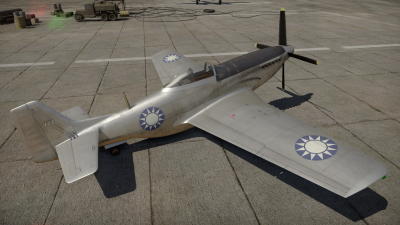
|
The first PLA Mustang was taken on 23 September 1948, after Captain Yang Peiguang (杨培光) of the 4th Fighter Wing of the ROCAF, based in Beiping, defected with his P-51D Mustang to the PLA. The PLA captured many more Mustangs during the Liaoshen Campaign of September through November 1948. At the Battle of Jinzhou (15 October 1948), thirty-one ROCAF Mustangs were captured. P-51D-25-NA, called "Red 3", with serial number 44-73920 is located at the China People's Revolution Military Museum (中国人民革命军事博物馆) in the Haidian District of Beijing. |
| P-51D-20-NA, Zroa HaAvir VeHahalal (Israeli Air Force) | |
|---|---|
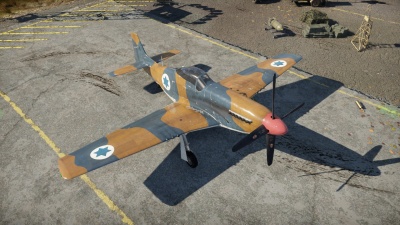
|
In the infancy years of Israel, the IAF was looking to expand the air force to ensure a worthy defence for independence and bought P-51's from across the world from surplus stock, coming from the USA, Sweden, Italy & Germany. Roughly totalling 79 operational & 26 airframes used as spare parts, which quickly became the backbone of the IAF. |
| P-51D-30 | |
|---|---|
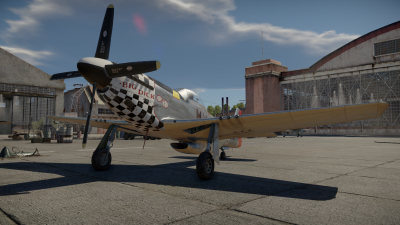
|
This version was developed just before the war ended. It's very similar to the previous version, but there are two significant differences, the first one is slightly increased limit of diving speed, the second one are changed engine settings and usage of 150 octane fuel, while for the D-5 and D-20 maximum manifold pressure rating with enabled WEP is 67" (1630 HP) and for the D-10 is 72" (1820 HP), for the D-30 it is increased even further, to 75" (1860 HP) and this gives it a slight speed advantage over the D-10 in War Thunder, by at least 5 mph in level flight. The P-51D-30 mainly served in the Korean War. |
| J26, Svenska Flygvapnet (Swedish Air Force) | |
|---|---|
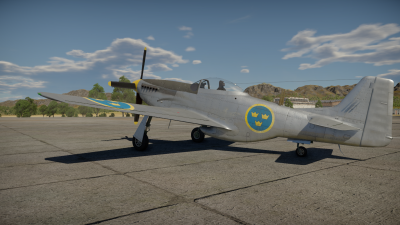
|
By the end of World War 2 the RSwAF ordered 157 Mustangs, which were delivered between 1945 and 1948 and their desination was changed to J26. They were replaced by jet aircrafts in 1952 and some had been sold to Israel and other countries. |
| P-51H-5-NA | |
|---|---|
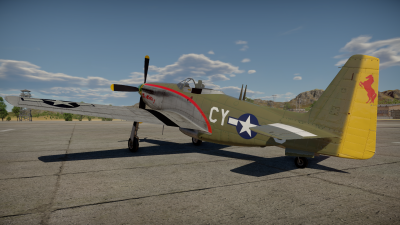
|
A lightweight version of the P-51, almost all parts of the plane were changed to reduce its weight and a new more powerful variant of the Merlin engine was installed. Wings shape, fuselage, landing gear, propeller and other parts had been changed visually, the plane was also longer than previous Mustangs, only some parts were interchangeable with the D version. Armament still consisted of six M2 Browning machine guns (wings were redesigned to make reloading ammo easier), it could also carry rockets or bombs. Performance-wise it was the best production P-51, it could reach 487 mph at 25,000 ft. Although 221 of them had been produced and delivered by 30 July none saw combat in World War II and after the war they were issued to reserve units. |
| P-51K, Republic of China Air Force | |
|---|---|
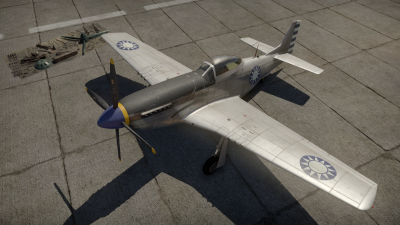
|
On 26 July 1950, the Squadron of Mustangs was named the Air Force 1st Independent Fighter Brigade (空军独立第一歼击机大队). By the end of August 1950, all the Mustangs had been removed from operational service and replaced by Soviet-built Lavochkin La-9 fighters. The Mustangs were retained as training aircraft by the Aviation School No.7, and thirteen were even modified into two-seat trainers. Only eight remained in service by September 1953, with the rest having been retired because of structural issues in the landing gear. P-51K-10-NT, called "Red 3032", with serial number 44-12458 remains at the Chinese Aviation Museum (中国航空博物馆) in Datangshan, Beijing. |
| F-82E | |
|---|---|
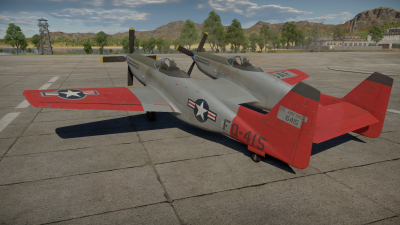
|
Designed to provide the US forces with long-range escort capabilities over the Pacific, the F-82 bore the appearance of desperate measures taken to use surplus P-51 parts. In reality, the F-82 was purposely designed as such in order to provide a fighter plane that had fresh pilots ready to engage, despite the tedious nature of long distance flights. Each fuselage carried a pilot and a co-pilot/navigator which reduced individual fatigue over long missions. The F-82 started development in 1944, with significant deliveries done in early 1946. Although too late for the war, the fighter still saw extensive use by Air Defense Command as an escort fighter and a night fighter. 14 F-82's were converted to winterized interceptors for use over Alaska. It also saw significant use in the Korean War with Japanese based (US planes deployed from Japan) F-82s among the first aircraft to operate over Korea. In fact, the first three North Korean aircraft shot down by US forces were done so by the Twin Mustang. |
| F-6C-10-NA, Forces Aériennes Françaises Libres (Free French Air Forces) | |
|---|---|
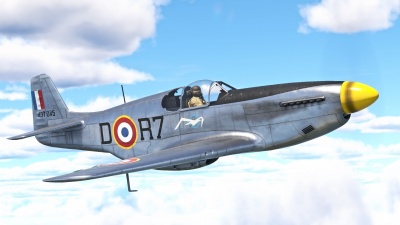
|
The first field modifications of the P-51 Mustang series for tactical photo reconnaissance appeared in the UK in 1941. In 1942, the United States began their conversion of P-51 Mustang fighters of various series into a reconnaissance fighter by equipping them with one or two bulky K-24 cameras manufactured by Kodak. These aircraft were used by the US Air Force, Britain, Australia, and were also delivered abroad under the Lend-Lease program. The reconnaissance Mustang was actively used during the Allied offensive in Europe, as well as in Tunisia and in the Pacifics. |
Who is the manufacturer of the Mustang?
| North American Aviation | |
|---|---|
| Fighters | |
| P-51A | P-51 · P-51A |
| P-51C | P-51C-10 |
| P-51D | P-51D-5 · P-51D-10 · P-51D-20-NA · P-51D-30 |
| P-51H | P-51H-5-NA |
| Twin-engine fighters | F-82E |
| Jet fighters | F-86A-5 · F-86F-2 · F-86F-25 · F-86F-35 · F-100D |
| Strike aircraft | A-36 · PBJ-1H · PBJ-1J |
| FJ-4B · FJ-4B VMF-232 | |
| Bombers | B-25J-1 · B-25J-20 |
| Export/Licence | ▂B-25J-30 · ␗B-25J-30 |
| ▄Mustang Mk IA · F-6C-10-NA · ␗P-51C-11-NT · ␗P-51D-20 · J26 David · J26 · P-51D-20-NA · ␗P-51K | |
| F-86F-30 ▅ · ␗F-86F-30 · F-86F-40 ▅ · F-86F-40 JASDF▅ · ␗F-86F-40 | |
| ◄F-86K · ▄F-86K (Italy) · ▄F-86K (France) | |
| ␗F-100A · ▄F-100D · ␗F-100F | |
| Captured | ▅P-51C-11-NT |
| Canadair Limited license-built the F-86 as the CL-13 for use in Canada and export to Europe. | |
| Fiat license-built the F-86K for the Italian Air Force though another 120 NAA built F-86Ks were also sold to the Italians. | |
| See Also | Mitsubishi Heavy Industries · Canadair Limited · Fiat Aviation |
Family Video!
Cool P-51 Facts
- P-51 variants P-51 (no suffix), A, and Mustang Mk I and II were the original Allison engined versions. These aircraft were originally named "Invader" by the USAAF, but soon changed to "Mustang" for consistency with the RAF version.
- A-36 was the ground-attack version of the P-51A. It featured dive brakes on the upper and lower surfaces of the wings. Its official name was "Apache", but was often referred to as "Invader" or "Mustang".
- P-51B, C, and Mustang Mk III featured a license-built British Merlin engine. The B and C models were identical, the only difference being the place of manufacture. The aircraft were originally designated P-78.
- P-51D, K, and Mustang Mk IV were the definitive bubbletop variants. The D and K differed only in the use of propeller.
- XP-51F, G, J and P-51H, L, and M were lightweight versions. Most were powered by Merlin engines, but the J was powered by an Allison. Only the H was mass produced, but was too late to see combat in WWII. The L and M were canceled after the war with only a single M produced.
- P-51s modified for photo-reconnaissance were redesignated F-6.
- P-51s still in service in 1947 were redesignated F-51s. This change was due to the Air Force breaking off from the Army.
- Some F-51Ds were modified as two-seat trainers. These are known as TF-51Ds.
- Commonwealth Aircraft Corporation in Australia produced P-51Ds locally as the CA-18 Mustang Mk 21, Mk 22, and Mk 23. The first such aircraft were assembled from kits supplied by the US under the designation CA-17 Mustang Mk 20. CAC also planned to produce the P-51H locally as the CA-21 Mustang Mk 24, but orders were cancelled after the war before any were built.
- After the war, Trans Florida Aviation (later Cavalier Aircraft Corporation) bought surplus P-51s and modified them into executive business aircraft. These were known as Cavalier Mustangs, many of which survive today but have been restored back into P-51s (most as TF-51s).
- Cavalier Aircraft Corporation also rebuilt P-51D airframes with upgraded military equipment for export to El Salvador and Indonesia under the designation Cavalier Mustang II.
- XP-82, P-82B, C, and D were basically two P-51Hs joined at the wing and counter-rotating propellers. The P-82 (later F-82) was known as the "Twin Mustang".
- XP-82A, F-82E, F, G, and H were powered by Allison engines as the Merlin was no longer produced in the US.
- PA-48 "Enforcer" was a heavily modified Cavalier Mustang with a turboprop engine. It was originally designated Cavalier Turbo Mustang III before it was sold to Piper Aircraft. It failed to receive a USAF contract, and only four aircraft were produced, ending Mustang production.
Media
- Videos


